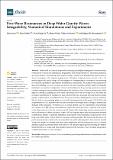Five-wave resonances in deep water gravity waves : integrability, numerical simulations and experiments
Abstract
In this work we consider the problem of finding the simplest arrangement of resonant deep-water gravity waves in one-dimensional propagation, from three perspectives: Theoretical, numerical and experimental. Theoretically this requires using a normal-form Hamiltonian that focuses on 5-wave resonances. The simplest arrangement is based on a triad of wavevectors K1+K2=K3 (satisfying specific ratios) along with their negatives, corresponding to a scenario of encountering wavepackets, amenable to experiments and numerical simulations. The normal-form equations for these encountering waves in resonance are shown to be non-integrable, but they admit an integrable reduction in a symmetric configuration. Numerical simulations of the governing equations in natural variables using pseudospectral methods require the inclusion of up to 6-wave interactions, which imposes a strong dealiasing cut-off in order to properly resolve the evolving waves. We study the resonance numerically by looking at a target mode in the base triad and showing that the energy transfer to this mode is more efficient when the system is close to satisfying the resonant conditions. We first look at encountering plane waves with base frequencies in the range 1.32–2.35 Hz and steepnesses below 0.1, and show that the time evolution of the target mode’s energy is dramatically changed at the resonance. We then look at a scenario that is closer to experiments: Encountering wavepackets in a 400-m long numerical tank, where the interaction time is reduced with respect to the plane-wave case but the resonance is still observed; by mimicking a probe measurement of surface elevation we obtain efficiencies of up to 10% in frequency space after including near-resonant contributions. Finally, we perform preliminary experiments of encountering wavepackets in a 35-m long tank, which seem to show that the resonance exists physically. The measured efficiencies via probe measurements of surface elevation are relatively small, indicating that a finer search is needed along with longer wave flumes with much larger amplitudes and lower frequency waves. A further analysis of phases generated from probe data via the analytic signal approach (using the Hilbert transform) shows a strong triad phase synchronisation at the resonance, thus providing independent experimental evidence of the resonance.
Citation
Lucas , D , Perlin , M , Liu , D-Y , Walsh , S , Ivanov , R & Bustamante , M D 2021 , ' Five-wave resonances in deep water gravity waves : integrability, numerical simulations and experiments ' , Fluids , vol. 6 , no. 6 , 205 . https://doi.org/10.3390/fluids6060205
Publication
Fluids
Status
Peer reviewed
ISSN
2311-5521Type
Journal article
Description
Funding: R.I. is partially supported by the Bulgarian National Science Fund, grant KΠ -06H42/2 from 27.11.2020.Collections
Items in the St Andrews Research Repository are protected by copyright, with all rights reserved, unless otherwise indicated.

